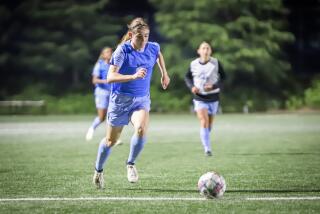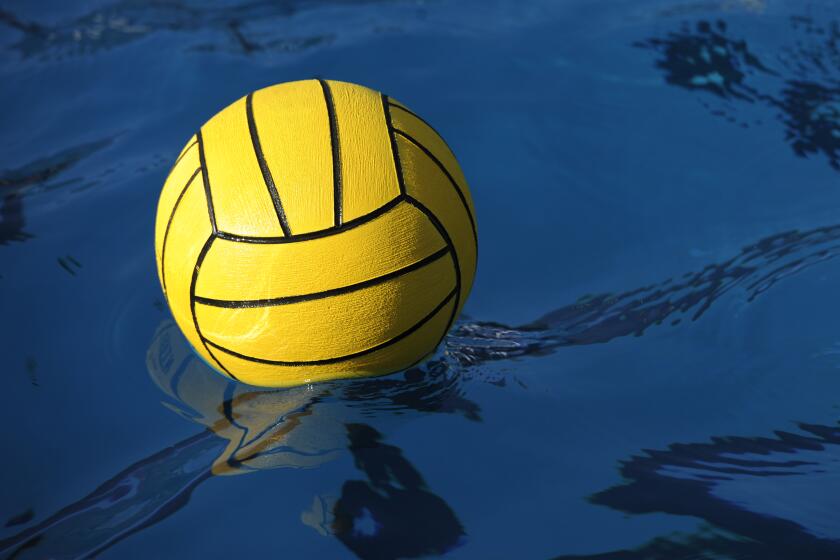San Diegans Lead Strong Southern California Contingent : Tennis: Rooks, Gavin and Velasco are seeded among top 12 in Girls’ 16 Nationals.
SAN DIEGO — Some of these girls will go out on a limb further than others.
As the Girls’ 16 National Tennis Championships get under way at Morley Field this weekend, seven Southern Californians are among the top 16 seeded players, and San Diegans have snared three of the top 12 spots.
“It’s a good year, average; it’s a nice year,” third-seeded Vanessa Rooks said with guarded optimism as she assessed the state of girls’ tennis in San Diego.
If anyone has room to be optimistic, it’s Rooks. The Spring Valley resident advanced furthest of the local players when, as the 20th seed last year, she reached the quarterfinals here. This year, she won all her matches as her team won inter-sectionals and she finished third in the Easter Bowl, both of which helped her achieve her No. 3 seeding.
“She could win; she’s real tough, a gutsy player,” said Lee Merry, who coached Rooks for two years. Merry, a staple on San Diego’s junior tennis scene for more than 10 years, currently oversees the progress of many of the area’s best 16-year-olds.
And Merry likes what he sees and the potential of the four local athletes, as nationals gets under way at 9 a.m. Sunday, after tonight’s opening ceremonies in Balboa Park.
“There’s a very strong Southern California contingent, including the girls from San Diego,” said Merry. “There’s not one standout player in 16s this year. The field’s pretty open as far as who can come through and win. It’s very deep; there’s not one or two great players.”
But there are a dozen or so very good ones. Joining Rooks as legitimate threats to top-seeded Amanda Basica of Lomita are eighth-seeded Marisa Velasco of Chula Vista, 12th-seeded Molly Gavin of Escondido and Rancho Penasquitos’ Mary Beth Maggert. La Jolla’s Erin Lowrey is an alternate in the 128-player draw.
Bill Foley, the director of junior tennis at Folsoms Tennis Club, can’t remember the last time San Diego was so strongly represented.
“You have three of the top 12 players from San Diego. That’s a very strong year,” he said. “They’re good solid players. All three are major college prospects.”
Which is plenty good enough for Gavin. The San Pasqual senior said she’s not looking toward a professional career, just a shot at a scholarship to a top 10 tennis school. Gavin got through four rounds of the consolation draw after losing in the first round in 1991.
“I think we have a great chance of doing well. We’ll be real rowdy,” said Gavin.
Velasco, who led the University of San Diego High to the San Diego Section 2-A team title then lost in the individual final, said she just hopes to represent San Diego the best she can.
All signs indicate she could do just that. Velasco, 15, finished fifth in singles and made it to the semifinals in doubles at Clay Court Nationals in Virginia two weeks ago. It was the best she’s even done in a national tournament.
“The girls have become stronger physically and mentally, and it gives them a big advantage,” said Velasco, who like six of the top eight seeds is a first-year player in this age group. “They hit the ball so hard and they’re in such great condition.”
Certainly that can be said about most of the high-ranked juniors these days. In the past few years, one of the trends has been toward better overall fitness and diet.
As they see it, even the younger players can no longer rely on their game alone to catapult them above the rest.
For some, that means watching what they eat and spending more time in the gym.
In addition to the three hours a day she spends on the court, Gavin runs, bikes or lifts weights for a half hour to 45 minutes a day.
“So many people are doing so many things,” she said. “You have to adopt some sort of regimen.”
Gavin recently took the fat out of her diet and can only stare at the burgers and ice cream her friends wolf down when they go out.
“I have to order frozen yogurt instead,” she said with a groan. “But it’s all right. I thought it would give me an edge, and it has. I have more energy. I don’t get tired so quickly.”
For some, what goes in the body physically can help what goes out of the mind psychologically.
“I’ve started to take vitamins,” Velasco said. “Before and sometimes even during matches I’ll drink Citomax and eat PowerBars. It really seems to help. At least mentally I think it does.”
Rooks, who coaches herself, knows how important a conditioning program is to her overall game.
“Everyone’s getting stronger and stronger. You have to do something to keep up,” said Rooks, who supplements her daily matches with weight training at Fitness Advantage.
Merry, co-owner of Merry-Blocher Tennis Academy in Escondido, acknowledges the importance of off-court training but said that too much, especially at a young age, isn’t wise.
“What hit other sports a long time ago is finally hitting tennis. More and more people are looking for an edge,” he said of the conditioning emphasis. “But you still have to hit the tennis ball, and hit it at the right time and in the right place.
“Sure there are added things you do to push yourself to another level, but too much of it can become counterproductive.”
Foley, who heads up a sports science program for the Southern California Tennis Assn., said tennis players are finding the tools to help them evolve into better all-around athletes.
“You want to be quicker, stronger, more flexible and have more endurance,” he said. “You have to go to the weight room for that. Tennis won’t do it if you want to get those foundations.”
Foley said over the years, coaches largely ignored two of the three components--physical, mental and emotional--that he said leads to better players.
“You need all three, but most coaches only work on the physical component,” he said. What you do off court is critical now and coaches need to tap into that.”
The San Diego players hope the components work well enough for them to tap into some victories.
More to Read
Get our high school sports newsletter
Prep Rally is devoted to the SoCal high school sports experience, bringing you scores, stories and a behind-the-scenes look at what makes prep sports so popular.
You may occasionally receive promotional content from the Los Angeles Times.






